
Introduction:Life Expectancy for Parakeets: Your Guide to a Long-Lived Bird
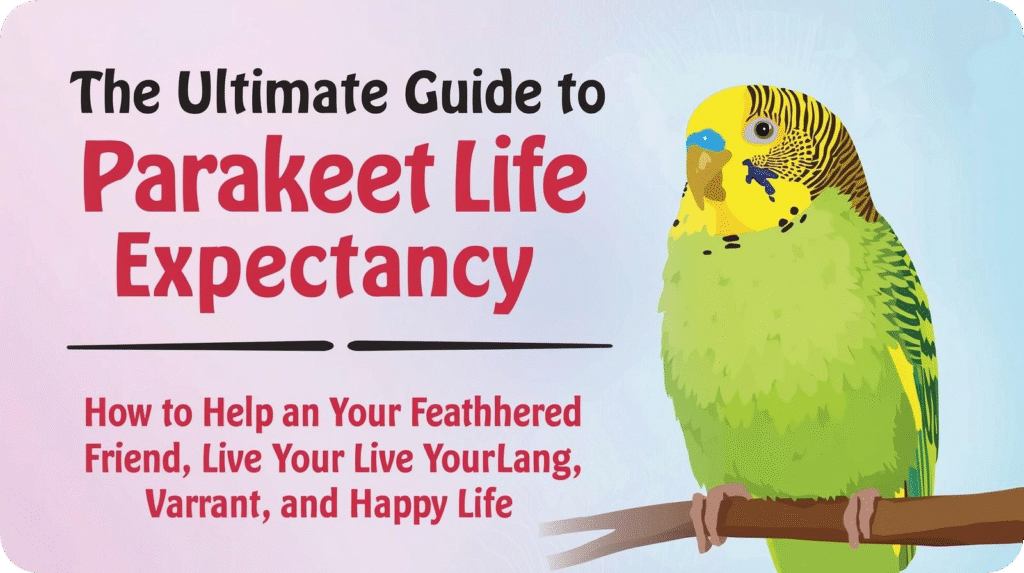
Welcome to the wonderful and rewarding world of life expectancy for parakeets! These small, colorful birds are more than pets.
Smart and Social Companions: They are intelligent and enjoy being part of the family.
Strong Bonds: Parakeets can form deep connections with their owners.
Endless Entertainment: They fill your home with cheerful chirps, playful antics, and even sweet conversations.
If you’re reading this, you’ve likely asked a critical question: “How long do parakeets live?”
The answer is both simple and profound. A wild parakeet usually lives 4 to 6 years.
However, a pet parakeet can live 7 to 15 years. Some special birds even reach their 20th birthday and beyond! This amazing difference is not just about safety from predators. It comes from the care, knowledge, and love given by their human families.
This ultimate guide is your roadmap to achieving that long, healthy life for your life expectancy for parakeets. We will journey beyond simple averages and delve into the science and heart of parakeet care.
Learn About Different Bird Species: Gain knowledge of the diverse bird species and their unique traits.
Understand What Affects Their Lifespan: Discover the key factors that impact their longevity.
Recognize and Prevent Common Health Problems: Identify common health issues and learn strategies to prevent them.
Finally, you will get a step-by-step plan to keep your bird healthy. Our goal is to empower you with the knowledge to not just add years to your parakeet’s life, but to add life to those years.
Life Expectancy for Parakeets: Understanding the Species

Life Expectancy for Parakeets: Understanding the Parakeet Family”
The term “parakeet” can be a source of confusion. In the United States, people often use the term to mean the Budgerigar. They affectionately call it the “Budgie.”
However, in the broader ornithological sense, “parakeet” is a term for a large group of small to medium-sized parrots characterized by their slender bodies, long, tapering tail feathers, and highly social nature. Knowing which species you have or are thinking about is the first step. This helps you give the right care. Different species can vary a lot in size, personality, and how long they live.
The Budgerigar (Melopsittacus undulatus) – The Beginner’s Best Friend
Origin & Habitat: Wild budgies come from the dry woodlands and grasslands of Australia. They live in large, moving flocks. This explains their strong need for social connection.
Appearance: Typically measuring 7 inches from head to tail tip, budgies are lightweight and graceful. Through selective breeding, they now show a stunning range of colors.
These colors go beyond the wild green and yellow. They include cobalt blue, violet, white, and even beautiful pied and spangled patterns. Mature males typically have a blue cere (the fleshy area above the beak), while females have a tan or brownish one.
· Personality & Talents: Budgies are the quintessential small parrot: curious, energetic, and incredibly social. They are known for their ability to mimic human speech and whistles. Some can learn hundreds of words. Their playful nature makes them delightful to watch and interact with.
· Average Lifespan in Captivity: 7 to 15 years. This is the standard for the common pet budgie, with exceptional care being the key to reaching the upper end and beyond.
The Ring-Necked Parakeet (Psittacula krameri) – The Elegant Talker
Origin & Habitat: These birds come from a wide area in Africa and South Asia. They have also built strong wild populations in many European cities.
· Appearance: A significantly larger bird, reaching up to 16 inches in length, much of which is tail. People recognize adult male birds for their bright colored ring around their necks. This ring is a mix of black and pink, which gives them their name. Their overall plumage is a vibrant green.
· Personality & Talents: Ring-necks are highly intelligent and possess an exceptional talent for clear speech. They can be more independent and strong-willed than budgies, requiring an owner who understands parrot psychology. Their loud, natural call is something potential owners should consider.
· Average Lifespan in Captivity: 25 to 35 years. This represents a multi-decade commitment, similar to that of a large parrot.
The Monk Parakeet – The Affectionate Architect of parakeet lifespan
Origin & Habitat: Originating from the temperate to subtropical regions of South America.
· Appearance: Recognizable by their bright green back, gray face, throat, and chest, which resembles a monk’s habit—hence the name. They are a medium-sized parakeet.
· Personality & Talents: Also known as Quaker Parrots, they are famously affectionate, comical, and talented talkers. They are the only parrots that build complex stick nests together. This happens even in captivity, and it is fun to watch.
· Average Lifespan in Captivity: 20 to 30 years.
The Alexandrine Parakeet lifespan (Psittacula eupatria) – The Gentle Giant
Origin & Habitat: Found in forests and woodlands across India and Southeast Asia.
· Appearance: One of the largest parakeet species, they can reach 25 inches in length. They have a massive red beak, a distinctive maroon shoulder patch, and a wider, more powerful build than the Ring-neck.
Personality & Talents: People generally recognize Alexandrines for their calm, gentle, and regal demeanor. They possess intelligence and can learn to talk, but people often prize them more for their steady and loyal companionship.
· Average Lifespan in Captivity: 30 to 40 years. Owning an Alexandrine is a lifelong commitment.
The Common Thread: What All Parakeets Share
Despite their differences, all parakeet species share core traits that define their care requirements:
High Intelligence: They are good at solving problems. They need mental challenges to avoid boredom. Without this, they may show destructive behaviors or feel depressed.
· Flock Mentality: In the wild, their survival depends on the flock. As pets, they transfer this need for social connection to their human families or avian companions. Loneliness is a serious health hazard for them.
Most parakeet species can mimic sounds. They copy everything from household noises to human speech. This helps them bond with their flock.
· Zygodactyl Feet: Two toes forward, two toes back. This foot structure makes them expert climbers and manipulators of toys and food.
The Lifespan Divide: Wild vs. Captivity
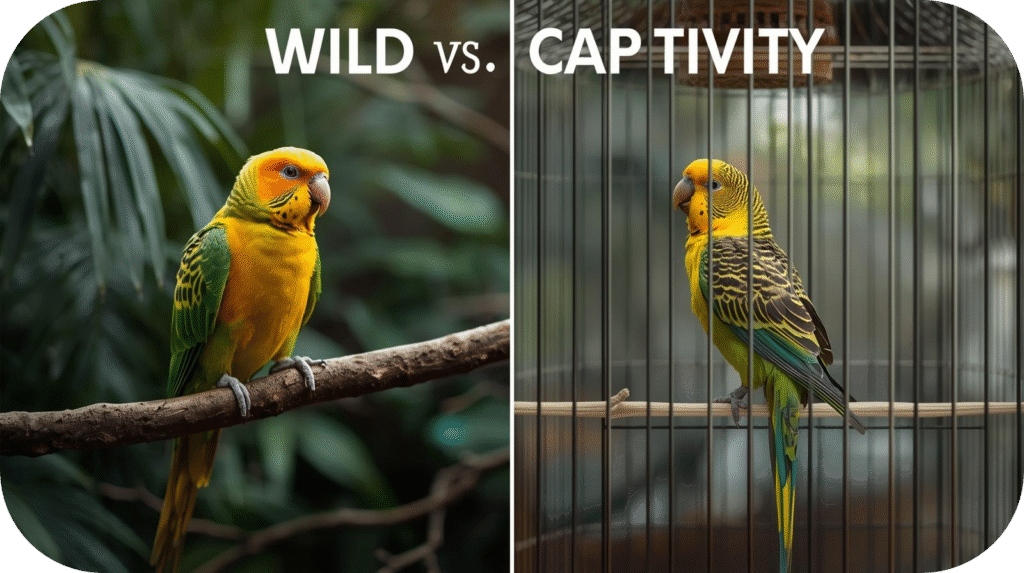
The Harsh Realities of Life in the Wild
Life for a wild parakeet is a constant struggle for survival. The average life expectancy of 4 to 6 years is a stark statistic driven by relentless challenges:
· Predation: They are a natural food source for hawks, falcons, snakes, and other larger animals. The stress of constant vigilance is immense.
Disease and Parasites: Without veterinary care, viruses, bacterial infections, and parasites can spread quickly and cause serious harm.
Food and Water Scarcity: Droughts, floods, and seasonal shifts can decimate food sources, resulting in starvation and dehydration.
Environmental Extremes: Harsh weather conditions—extreme heat, freezing cold, and violent storms—take a significant toll on wildlife.
Human-Related Threats: Habitat destruction and pesticide use continue to jeopardize wild parakeet populations.
The Promise of a Protected Life in Captivity
The dramatically extended lifespan in captivity is a testament to the safety and care we provide. By removing the threats of the wild, we give them the foundation for a long life.
Captivity brings its own challenges, like poor diet, bad housing, and lack of social interaction. Because of this, a typical budgie may only live 7 to 8 years with average care. However, a budgie with a knowledgeable owner can live 15 years or more. The record for the oldest budgie is a staggering 29 years, proving what is possible.
The Blueprint for Longevity: Key Factors Determining Lifespan
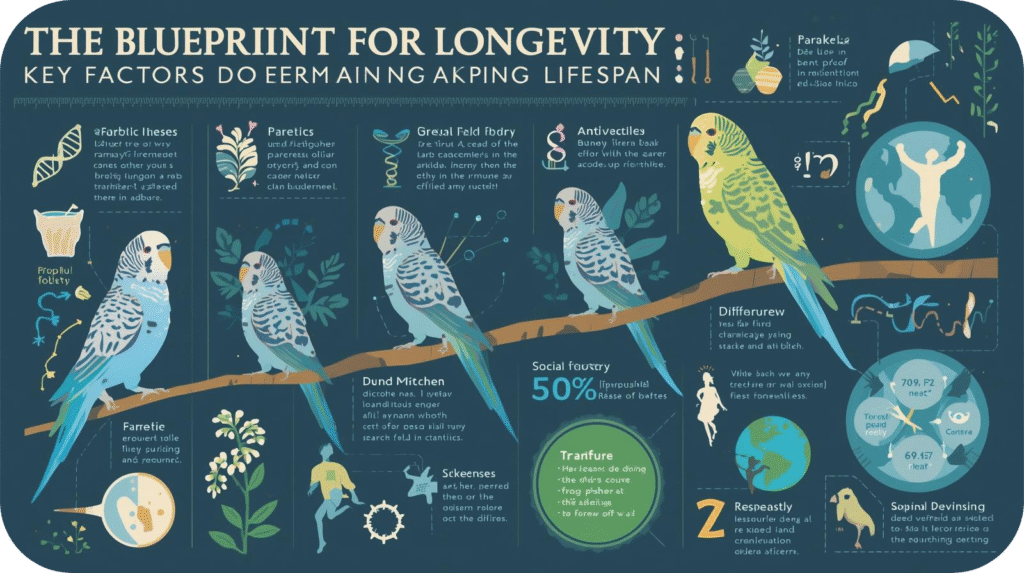
Your parakeet’s lifespan is not predetermined. It is a living equation, and you control the most important variables
Genetics and Breeding: The Foundation
Think of genetics as your parakeet’s starting hand in the game of life.
· Responsible Breeders: Ethical breeders prioritize health, genetic diversity, and temperament. They avoid inbreeding, which can lead to congenital weaknesses, immune system deficiencies, and shorter lives.
Problematic Sources: Birds from big breeding mills or pet stores that do not share their sources often have health issues from birth. Supporting responsible breeders is an investment in your bird’s future health.
Diet and Nutrition: The Cornerstone of Health

This is, without exaggeration, the single most influential factor under your control. A poor diet is a slow-acting poison
The Danger of an All-Seed Diet
Many new owners mistakenly believe a seed mix is a complete diet. This is a dangerous myth. Seeds are:
High in Fat: Can lead to obesity and life-threatening fatty liver disease.
Low in Vital Nutrients: Often critically deficient in Vitamin A, calcium, and essential amino acids.
Incomplete Nutrition: Fails to provide the balanced spectrum of nutrients needed for a parakeet to thrive.
The Ideal Diet: A Balanced Approach
Transitioning your bird to a balanced diet is the greatest gift you can give them.
High-Quality Pellets (60-70% of diet): These special pellets provide complete nutrition. They stop your bird from only eating its favorite, unhealthy seeds.
Offer fresh vegetables (20-30% of diet) daily. Excellent choices include dark leafy greens (kale, spinach, chard), carrots, sweet potatoes, broccoli, and bell peppers. These contain vitamins and antioxidants.
· Fruits (5-10%, as treats): Offer in moderation a few times a week. Berries, apples (seeds removed), melon, and papaya are great options.
· Healthy Seeds and Grains: Use a small amount of a high-quality seed mix as a treat or for training. Sprouted seeds are a healthier option as the sprouting process increases their nutritional value.
Essential Supplements: A cuttlebone or mineral block should always be available. This provides calcium for strong bones and healthy beaks. Iodine blocks can also help prevent thyroid issues.
Environment and Housing: Creating a Safe Haven

Your parakeet’s cage is its territory, its safe space, and its playground. An inadequate environment is a significant source of stress and health problems.
Selecting the Perfect Cage
Size: The golden rule is: buy the largest cage you can possibly afford and accommodate. The absolute minimum for a single budgie is 18″ L x 18″ W x 18″ H, but this is a starting point. Larger species require significantly more space. The cage should be wide enough to allow for short flights between perches.
· Bar Spacing: For budgies and other small parakeets, spacing must be no wider than 1/2 inch to prevent injury or escape.
· Shape and Design: Rectangular cages are superior to round ones. Round cages lack corners, which birds use as safe retreats when they feel threatened, and can cause disorientation.
Furnishing for Health: Boosting Parakeet Life Expectancy
Varied Perches: Ditch the uniform, sandpaper-covered dowel perches. Provide a variety of natural wood branches (manzanita, dragonwood, applewood) in different diameters (from 3/8″ to 3/4″). This variation is critical for foot health, preventing pressure sores and arthritis.
· Mental Enrichment (Toys): Boredom is a disease for an intelligent creature. Provide a rotating collection of toys:
A rotating selection of toys is essential for your parakeet’s mental and physical health.
Provide a variety of types to cater to their instincts: foraging toys challenge their problem-solving skills, destructible toys satisfy their innate need to chew, noise-making toys offer auditory stimulation, and swings and ladders encourage active movement and play.
· Strategic Placement: Place the cage in a part of your home that has steady family activity, like a living room, but avoid:
Strategic cage placement is vital for your parakeet’s health. Avoid areas with direct sunlight and cold drafts from windows or doors. The kitchen is particularly dangerous, as fumes from Teflon/non-stick pans are instantly lethal. Finally, keep the cage out of the direct line of sight of a television or speakers, as constant loud noise can be a source of chronic stress.
Life Expectancy for Parakeets: Social and Mental Health Matters
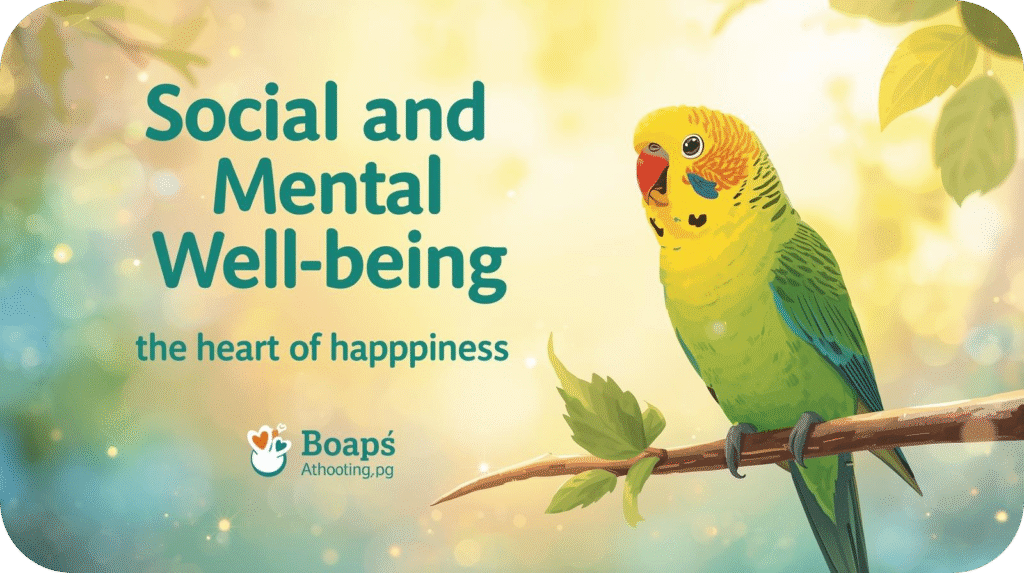
A parakeet’s emotional health is inextricably linked to its physical health. A lonely, stressed bird will have a weakened immune system.
· The Problem of Loneliness: In the wild, a parakeet alone is a dead parakeet. This instinct runs deep. A solitary bird without interaction can develop severe psychological issues like chronic stress, depression, and the heartbreaking behavior of feather-plucking (self-mutilation).
Enhancing Life Expectancy for Parakeets with a Rich Social Life
You have two excellent paths to ensure your parakeet’s social needs are met:
1. The Companion Bird: Getting a second parakeet is often the ideal solution. They can preen each other, play, chatter, and provide constant companionship. This is highly recommended, especially if you are away from home for long hours.
2. You Are The Flock: If you choose to have a single bird, you must commit to being its flock. This means a minimum of 1-2 hours of direct, out-of-cage, interactive time every single day. This includes training, talking, and handling them. You can also let them sit on your shoulder while you do your activities.
Preventive and Proactive Care for Parakeets
Birds are masters at hiding signs of illness, a survival instinct from the wild where showing weakness makes them a target. Therefore, a proactive approach is non-negotiable.
The Role of an Avian Veterinarian
Do not wait for an emergency to find a vet. Locate a certified avian veterinarian—a specialist in bird medicine—and establish a relationship.
· Annual Wellness Exams: Just like a human physical, an annual check-up is crucial. The vet will check the pet’s weight.
They will examine the feathers and listen to the heart and lungs. The vet can also do routine blood tests. These tests can find problems like liver or kidney disease before symptoms show up.
· Be a Keen Observer: You are your bird’s first line of defense. Learn its normal behavior, appetite, and droppings. Early signs of illness include:
Be a keen observer, as any change in behavior is a potential red flag for illness. Key warning signs include a fluffed-up posture for extended periods, excessive sleeping during the day, and a loss of appetite or increased thirst. Physically, monitor for changes in droppings (color, consistency, or amount) and respiratory symptoms like wheezing, sneezing, or tail-bobbing. A bird sitting on the cage floor when it normally perches is another critical sign of distress that requires immediate attention. When in doubt, call your vet.
Life Expectancy for Parakeets: From Hatchling to Senior
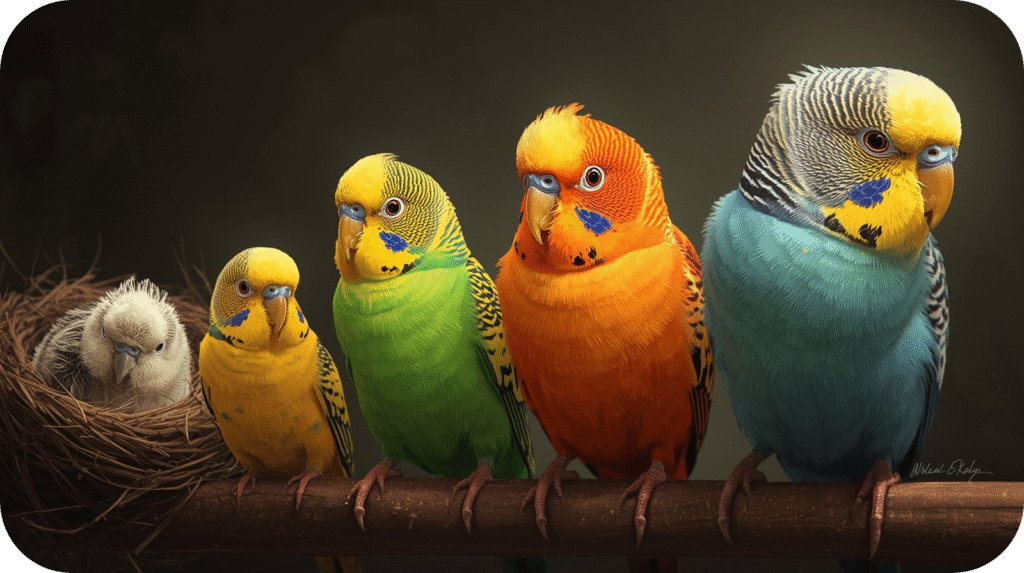
Understanding the different life stages helps you tailor your care to their evolving needs.
A parakeet’s life journey begins as a completely dependent, blind, and featherless hatchling. Between 10 days and 6 weeks, as a nestling and fledgling, it undergoes rapid growth, sprouting feathers and learning to leave the nest and self-feed. By the juvenile stage (8 weeks to 6 months), the bird is weaned and becomes an independent, energetic explorer.A key characteristic of this juvenile stage is their duller coloration compared to adults. In budgies, this is marked by the head barring extending all the way down to the cere.
A period of high energy and exploration.
· Young Adult (6 months – 2.5 years): Reaches sexual maturity. Adult plumage comes in, and personality solidifies. This is a prime time for training and socialization.
· Adult (2.5 – 6 years): The prime of life. Full vibrancy in color and personality. For many species, these are the primary breeding years.
· Senior (6+ years for budgies): Just like people, older birds may slow down. They might sleep more, be less active, and require more rest. Their diet may need changes, like softer foods if their beak grows too long.
They also benefit from more vet check-ups. These visits help check for age-related problems, such as arthritis or heart disease.
Life Expectancy for Parakeets: Common Health Issues and Prevention”
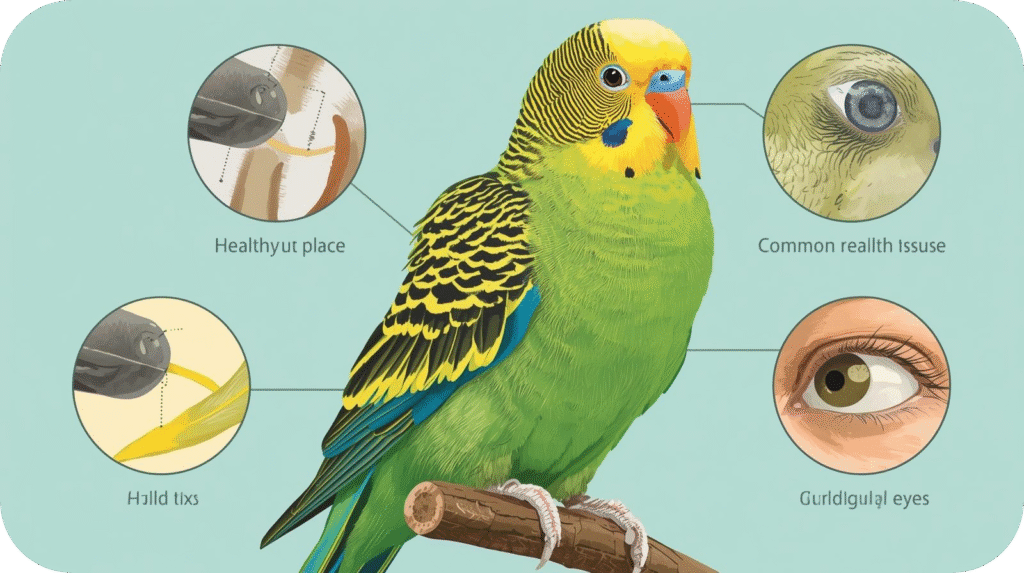
The following table provides an in-depth look at common parakeet ailments. An informed owner is a parakeet’s best advocate.
Health Issue
Description, Causes & Symptoms
Prevention & Action
Scaly Face & Leg Mites
Cause: A microscopic mite (Knemidocoptes pilae) that burrows into the skin, particularly around the beak, eyes, and legs.
Symptoms: A crusty, honeycombed or lumpy appearance on the cere and beak. Can lead to beak deformity if untreated. On legs, it creates raised, scaly deposits.
Prevention: Maintain a clean environment. Quarantine new birds.
Action: Requires prescription medication from an avian vet (e.g., Ivermectin). Highly contagious to other birds.
Psittacosis (Parrot Fever)
Cause: The bacterium Chlamydia psittaci. A zoonotic disease means that animals can transmit it to humans.
Symptoms can be unclear. They include tiredness, eye discharge, trouble breathing (like sneezing), and green or yellow-green urates (the white part of droppings). Weight loss is also a sign.
Prevention: Quarantine all new birds for at least 30-45 days. Practice good hygiene.
Action: SEEK VETERINARY CARE IMMEDIATELY. Diagnosis requires specific tests. Treatment involves a long course of antibiotics.
Avian Gastric Yeast (AGY)
Cause: An overgrowth of the yeast Macrorhabdus ornithogaster in the proventriculus (true stomach).
Symptoms: Chronic weight loss despite a ravenous appetite, undigested seeds in droppings, vomiting, a visibly distended crop, and sometimes black or tarry droppings.
Prevention: Stress reduction and good hygiene are key.
Action: A vet can diagnose via a fecal gram stain or PCR test. Treated with antifungal medications added to water or food.
Vitamin A Deficiency
Cause: A direct result of an all-seed diet, as seeds are devoid of Vitamin A.
Symptoms: White plaques in the mouth, swollen eyes, respiratory issues (due to infections in the mucous membranes), poor feather quality, and overgrown beak/toenails.
Prevention: Feed a diet rich in Vitamin A. This includes dark leafy greens, orange vegetables (carrots, sweet potato), and red peppers. Pellets are fortified with Vitamin A.
Fatty Liver Disease
Cause: Long-term, high-fat diet (seeds) and obesity. Fat infiltrates the liver, and it can no longer function properly.
Symptoms: Obesity, black spots on the beak, a yellowish tint to the skin (jaundice), and lethargy.
Prevention: The primary prevention is a pelleted diet and limited seed intake. Ensure daily exercise.
Action: A vet can diagnose with blood tests. Treatment involves dietary correction and supportive liver supplements.
Egg Binding (Dystocia)
Cause: A life-threatening condition where a female cannot pass an egg. Risk factors include calcium deficiency, obesity, first-time laying, and genetics.
Symptoms: Straining, sitting on the cage floor fluffed up, weakness, tail bobbing, and a swollen abdomen.
Prevention: Provide a constant source of calcium (cuttlebone). Only provide nest boxes if you desire intentional breeding.
Action: THIS IS AN EMERGENCY. The bird will die without intervention. Provide warmth and humidity and get to an avian vet immediately for calcium injections and possible medical extraction.
Feather Plucking
Cause: A complex issue with both medical and behavioral roots. Medical causes include parasites, skin infections, or pain. Behavioral causes are often chronic boredom, stress, or lack of social interaction.
Symptoms: Bald patches, broken blood feathers, and damaged skin, typically on the chest, legs, and under the wings.
Prevention: Address the root cause! Provide ample mental stimulation, social interaction, and a large, enriching environment.
Action: First, see an avian vet to rule out every possible medical cause. Once you exclude medical issues, work with the vet on behavioral and environmental modifications.
Life Expectancy for Parakeets: 10 Steps to a Longer Life

1. Commit to a Superior Diet: Begin the transition from seeds to a high-quality pellet base. Introduce a colorful variety of fresh, bird-safe vegetables daily. Eliminate toxic foods entirely (avocado, chocolate, caffeine, alcohol, onion, garlic).
2. Invest in a Spacious, Safe Cage: Upgrade to the largest, best-designed cage your space and budget allow. Ensure bar spacing is safe and the shape is rectangular.
3. Furnish for Fitness and Fun: Offer different natural wood perches and a changing selection of toys. These should encourage foraging, chewing, and play. Change the toy layout weekly to keep the environment novel.
4. Guarantee Daily Flight Time: Allow at least one hour of supervised flight outside the cage every day in a safe room. This is non-negotiable for physical and mental health.
5. Fulfill Their Social Needs: Either get a compatible parakeet friend or be their main companion. Spend time with them daily and train them.
6. Partner with an Avian Veterinarian: Schedule an initial wellness exam and establish a plan for annual check-ups. Do not wait for sickness to find your vet.
7. Become a Cleaning Connoisseur: Perform spot cleaning of food/water dishes and the cage floor daily. Conduct a thorough cage breakdown and cleaning with a bird-safe disinfectant weekly.
8. Master Bird-Proofing: Before letting your bird out of its cage, cover windows and mirrors. Turn off ceiling fans, close toilet lids, and remove other pets from the room.
9. Learn the Language of Your Bird: Spend time simply observing. Learn what their different postures, vocalizations, and droppings mean. You are the best person to notice the subtlest sign of illness.
10. Offer Unconditional Love and Patience: Build a relationship based on trust, not force. Use positive reinforcement. A secure, loved bird is a resilient and healthy bird.
Lifespan Comparison: How Does Your Parakeet Measure Up?
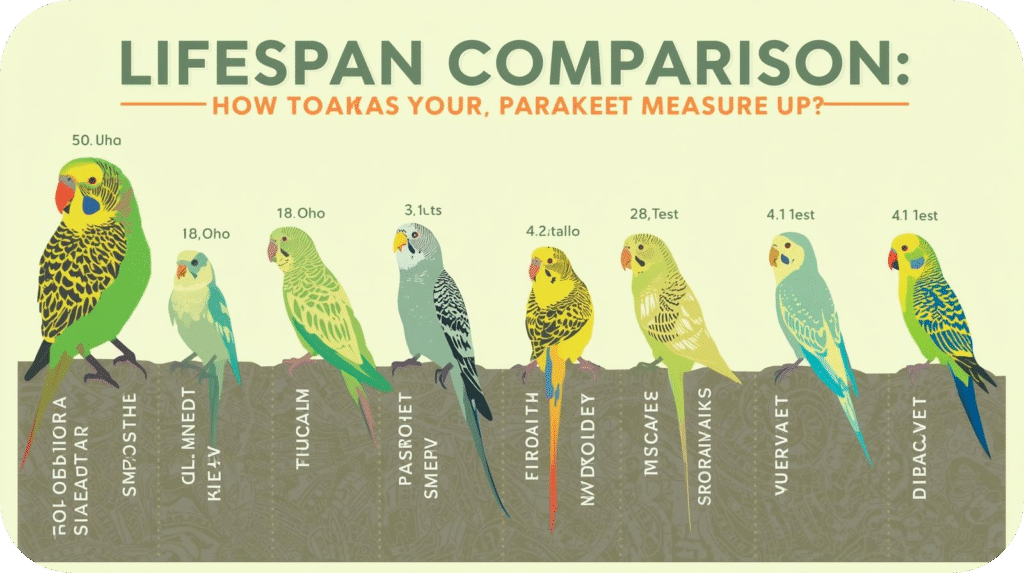
Bird Species
Average Lifespan in Captivity
Key Considerations
Budgerigar (Budgie)
7 – 15 years
The most common parakeet; lifespan highly dependent on diet and care quality.
Cockatiel
15 – 20 years
A slightly larger, gentle cousin of the cockatoo, known for their crest and whistling.
Lovebird
10 – 15 years
Small but feisty; often do best in pairs and are incredibly active.
Ring-Necked Parakeet
25 – 35 years
A long-term commitment requiring an experienced owner who can handle their intelligence and voice.
Monk Parakeet (Quaker)
20 – 30 years
Affectionate and talkative, but their nest-building instinct is strong. Illegal to own in some states.
Alexandrine Parakeet
30 – 40 years
A calm, gentle giant among parakeets; a true lifelong companion.
African Grey Parrot
40 – 60 years
One of the most intelligent birds; demonstrates that larger parrots generally have longer lifespans.
Conclusion: The Power is in Your Hands

The life expectancy for parakeets tells a story of two possible futures. One is short and fraught with peril, the natural course of the wild. The other is a long, vibrant, and deeply connected life, made possible by you.
Your parakeet’s genetics may set the potential, but your care determines the reality. The food you choose, the home you create, the friendship you give, and the healthcare you offer are what turn potential into years. The legendary parakeets that live into their twenties are not flukes; they are the products of dedicated, knowledgeable caregivers.
Owning a parakeet is a promise—a promise to be a good steward of a tiny, magnificent life. It is a commitment that asks for your time, resources, and heart.
In return, you receive a great reward. This includes the song, the spirit, and the loyal friendship of a wonderful creature. You can enjoy this for its entire long and happy life.
Frequently Asked Questions (FAQs)
What is the most common type of parakeet and its average lifespan?
The Budgerigar, or Budgie, is the most common parakeet kept as a pet worldwide. With proper care, its average lifespan is 7 to 15 years.
Is it better to have one parakeet or two?
For their mental well-being, two parakeets are generally better than one. They provide each other with constant companionship. If you choose to have a single bird, you must prepare to spend several hours with it daily to prevent loneliness and depression.
Life Expectancy for Parakeets: Toxic Hazards to Avoid
The top dangers are:
To protect your parakeet, you must be aware of common household hazards. Toxic fumes from Teflon/non-stick cookware, aerosol sprays, smoke, and strong chemicals can cause sudden death. Poisonous foods to avoid entirely include avocado, chocolate, caffeine, alcohol, onion, and garlic. Finally, manage environmental dangers such as ceiling fans, open toilets, uncovered windows and mirrors, and other pets like cats and dogs.
Life Expectancy of Parakeets: How Stress and Unhappiness Impact Their Lifespan
Signs of stress include:
Your parakeet may be stressed or unhappy if it displays several key warning signs. These can include behavioral changes like aggression, fearfulness, or constant repetitive actions such as pacing and bar chewing. Physically, watch for a loss of appetite or more severe symptoms like feather plucking and self-mutilation. Additionally, listen for excessive screaming, which is distinctly different from their normal, happy chirping.
My parakeet is 8 years old and seems less active. Is this normal?
Yes, people consider an 8-year-old budgie a senior citizen. A gradual reduction in activity and an increase in sleep are normal parts of aging.
Now is the time to pay close attention to their health. Make sure their environment is easy to navigate. Also, keep up with regular vet visits to help them stay comfortable in their golden years.

Leave a Reply